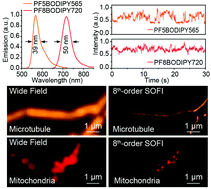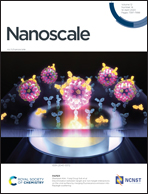Narrow-band polymer dots with pronounced fluorescence fluctuations for dual-color super-resolution imaging†
Abstract
Super-resolution optical fluctuation imaging (SOFI) produces fast, background-free, super-resolved images by analyzing the temporal fluorescence fluctuations of independent emitters. With sufficient brightness and fluctuations, a higher order of image processing affords a higher resolution and in principle the resolution enhancement is unbounded. However, it is practically challenging to find suitable probes for high-order SOFI. Herein, we report two types of BODIPY-based polymer dots (Pdots) with narrow-band emissions, pronounced fluctuations, and prominent photostability, thus enabling high-order, dual-color SOFI nanoscopy. Single-particle and subcellular SOFI analysis reveals the superior performance of the BODIPY Pdots as compared to conventional streptavidin-conjugated Alexa dyes. In contrast with wide-field images, the spatial resolution (∼57 nm) was enhanced by ∼6.0-fold in 8th-order single-particle SOFI nanoscopy. A spatial resolution (61 nm) was obtained for single microtubules labeled by the BODIPY Pdots, while the majority of the subcellular structures were lost for those labeled by streptavidin-Alexa dyes in 8th-order SOFI. This work indicates the unprecedented performance of Pdot probes for multi-color subcellular SOFI applications.



 Please wait while we load your content...
Please wait while we load your content...